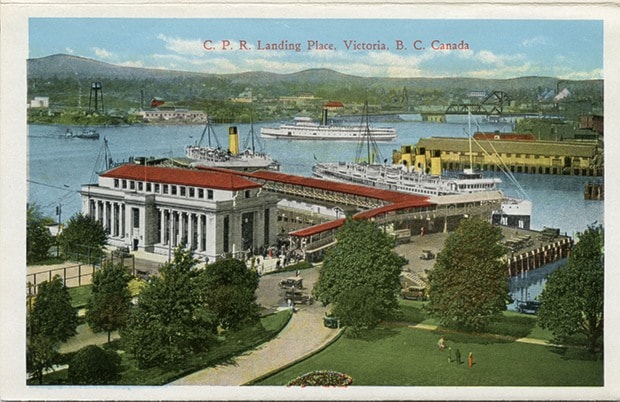At the dawn of the 20th century, Victoria was a city on the move. As Canada’s Pacific gateway, its natural advantages included a mild climate and impressive central harbour.
As refined capital of a booming province, its position held great promise for it to profit from trade and tourism routes throughout the British Empire and the world. However, its poor shipping connections with the Pacific terminus of the Canadian Pacific Railway (CPR) in Vancouver impeded future growth.
Seeking to improve the Victoria to Vancouver steamer service, Canadian Pacific Navigation Company (CPN) purchased land on Belleville Street in 1899 to expand operations but they lacked sufficient resources to proceed. In 1901, the deep-pocketed CPR acquired a controlling interest in CPN and purchased the company outright in 1903. Under the leadership of Captain James Troup, CPR moved quickly to establish a proper B.C. Coastal Service by developing an impressive fleet of modern “pocket liners.”
With luxurious sleeping rooms and stylish lounges, the Pacific Princesses inaugurated an era of glamorous travel on British Columbia’s coastal waters and complimented the company’s established fleet of Empress liners which serviced international routes. In 1904, CPR commissioned the young architect Francis Rattenbury, lauded for his design of the B.C. Parliament Buildings, to develop a steamship ticket office on the Belleville site. Opened in 1905, the timber-framed, Tudor-style structure was modeled after the residential estates Rattenbury had previously designed.
The B.C. Coastal Service boomed, driven by strong demand on the famous “triangle route” between Victoria, Vancouver and Seattle. Ships such as Princess Mary, Princess Patricia and Princess Maquinna became household names. The era’s best known ship was the sleek and elegant Princess Victoria, which set new speed records on the Vancouver crossing, and generated considerable pride in its namesake homeport.
By the 1920s, tourist traffic exceeded the capacity of the existing fleet and the rise of automobiles required new vessels with the ability to carry vehicles as well as passengers. Victoria had lived up to its promise as a city with a bright future.
The Rattenbury-designed Parliament Buildings and Empress Hotel, opened in 1898 and 1908 respectively, had created a brilliant inner harbour panorama that Rattenbury was proud to consider his “life’s work.”
In 1923, CPR asked Rattenbury to design a grand new terminal to replace his earlier Tudor-style structure. Rattenbury pledged to create “a building that would harmonize and add to the beauty” of the harbour precinct.
With support from architect Percy James, Rattenbury envisioned a glittering new Pacific headquarters that would befit the CPR’s power and prestige. He designed a monumental Greek waterfront temple with massive Ionic columns, Welsh slate roof and an exterior adorned at each corner with carved heads of Poseidon – the Greek god of the sea.
Workmen began tearing down the old ticket office in August 1923 and construction began shortly thereafter. A novel technique was used to keep standards high and costs low. Imitation sandstone for the facade was created in moulds in the building’s basement using a mixture of white cement and pulverized marble and granite.
When completed, the terminal’s reception area featured 17-foot ceilings, a grand central fireplace, marbled waiting rooms and floor-to-ceiling windows with spectacular views of passing ships. The total cost of the building was $250,000.
CPR’s “Temple of Poseidon” opened during the summer of 1924, in anticipation of welcoming two new ships which had been commissioned to modernize the fleet. Princess Kathleen and Princess Marguerite could each carry 1,500 passengers as well as 30 automobiles. Concurrent upgrades to the CPR piers in Seattle and Vancouver enhanced the overall triangle service.
The CPR terminal was the last building Rattenbury designed in the Inner Harbour. He considered it “as good as anything I have ever done” and its success led to him joining the Royal Architectural Institute of Canada.
For decades, it welcomed the world to its wharves. But by the 1950s, the CPR service was in decline and its aging fleet was no longer the toast of the town. In 1958, strikes caused severe disruptions to CPR’s coastal service and helped convince Premier W.A.C. Bennett to create B.C. Ferries. Over time, guests on CPR’s overnight services to Vancouver were outnumbered by crew as competition grew from government car ferries, new private operators and airlines. CPR transferred its coastal headquarters to Vancouver and in 1970 leased the building to the Royal London Wax Museum.
CPR ended passenger services in 1974 and sold the terminal to the province the following year. The wax museum closed in 2010 and in 2012, Greater Victoria Harbour Authority assumed the head lease and invested $2.6 million in renovations. Current tenants include Robert Bateman Centre, Steamship Grill and Bar and Starbucks. Potential new tenants include Oceans Networks Canada and Riverside Marine, with exciting plans to return the building to its transportation roots by inaugurating a new Victoria to Vancouver marine passenger service.
On Canada Day this year, the Harbour Authority unveiled dusk-to-dawn lighting which can display a variety of colours to spotlight the building’s heritage features and highlight its continuing role as the shining temple of tourism in Victoria’s spectacular harbour panorama.
Ivan Watson is a historian and media relations specialist for the Greater Victoria Harbour Authority. You can follow him on Twitter @watsonivan or email him at: iwatson@gvha.ca.
